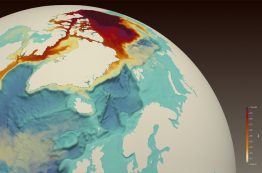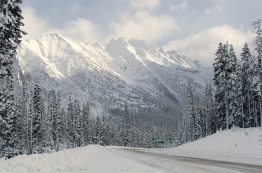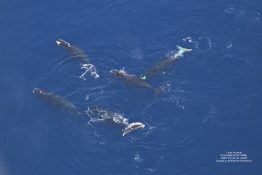When you try to imagine what a happy, calm beluga whale looks like, what images do you conjure up? A smiling white blob, reclining on a chaise lounge with a shrimp cocktail? A zen-like cetacean emerging from a meditation workshop session with a rolled-up mat under its flipper? For Manuel Castellote, a researcher at the Cooperative Institute for Climate, Ocean and Ecosystem Studies (CICOES), the image is less absurd but more exciting.
Read more »Record-high Arctic freshwater will flow through Canadian waters, affecting marine environment and Atlantic ocean currents
Freshwater is accumulating in the Arctic Ocean. The Beaufort Sea, which is the largest Arctic Ocean freshwater reservoir, has increased its freshwater content by 40% over the past two decades. How and where this water will flow into the Atlantic Ocean is important for local and global ocean conditions. A study from the University of Washington, Los Alamos National Laboratory and the National Oceanic and Atmospheric Administration shows that this freshwater travels through the Canadian Archipelago to reach the Labrador Sea, rather than through the wider marine passageways that connect to seas in Northern Europe.
Read more at UW News »Online tool displays Pacific Northwest mountain snow depth
How’s the snow on Northwest mountains this year? Overall a little deeper than normal, but it depends where you look. A new collaboration between the University of Washington and the Northwest Avalanche Center lets you see how the current snow depth compares to past years for nine sites in Washington and two in Oregon. The new mountain snow depth tool is freely available on the Office of the Washington State Climatologist’s website.
Read more at UW News »A whale murder mystery in the Arctic
From a small aircraft flying over the Pacific Arctic, scientists with the Aerial Surveys of Arctic Marine Mammals (ASAMM) project surveyed the movements and interactions of marine mammals for more than four decades. Observations and images from these surveys offer clues informing our understanding of the lives, and deaths, of marine mammals in this remote region. A new study, published in Polar Biology and led by researchers at the University of Washington’s Cooperative Institute for Climate, Ocean, and Ecosystem Studies (CICOES), is particularly interested in the ‘death’ part of those survey observations, and has uncovered the first direct evidence of killer whales as the primary cause of death for one of the Arctic’s endangered species, bowhead whales of the Bering-Chukchi-Beaufort seas stock.
Read more »Diversity, equity and inclusion at UW Environment
The tragic events of spring quarter have emphasized the tremendous amount of work that still needs to be done to counteract the mistreatment and marginalization of Black, Indigenous and people of color (BIPoC) and create an environment that is more just, more equitable and more inclusive. Schools, programs, institutes and departments within the College of the Environment have been working hard to refine, rethink and deepen their work in the Diversity, Equity and Inclusion (DEI) space, often led by unit-level diversity committees.
Read more »





